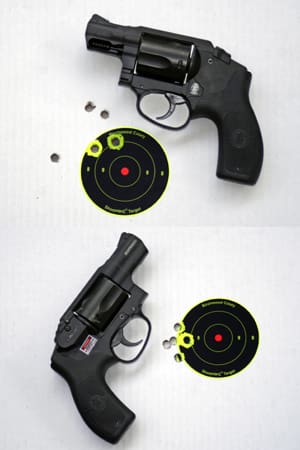Regular readers will know that TTAG has had a major beef with Ruger re: the trigger on the SR40. The go pedals on the guns we sampled (more shocking info to follow) stage like the Royal Opera, stack like a Jenga competition coordinator and have a less defined breaking point than waves on a windy day in a sheltered bay. We’ve also tested the Chiappa Rhino. V1’s trigger was harder than trigonometry. V2’s was lighter than a flea fart, leading to a failure to fire. Do we need to talk about Remington’s trigger troubles—however apocryphal—with the Model 700? And now comes news that the trigger on the new Smith & Wesson Bodyguard sucks. Sorry, I mean it’s a “disappointment.” Other than that, officer.com gun reviewer Steve Denney pulls no smooth trigger. I mean, punches . . .
Pull weight is not bad, probably in the 12 to 14 pound range, and trigger reach is no problem. What bothers me is that the relatively long travel of the trigger has a couple of spots where it feels stagey and you can literally stop and hold the trigger as if they are rest areas. If you pull the trigger relatively quickly and smoothly, it is not as noticeable, but if you are trying for a slow, smooth stroke for maximum accuracy it is a bit of a nuisance. I can stage the trigger every time, predictably and in exactly the same spot on each pull.
On the Ruger SR40, the crap trigger isn’t such a big deal. It’s a full-size .40-caliber gun— hardly a target shooter’s first choice. Aim and pull and you’ll probably hit what needs hitting. With the Rhino, dear dear dear oh dear dear dear oh dear dear oh dear no. As for a polymer revolver called a “Bodyguard”, to quote my surly step-daughter, fail.
Unfortunately, staging the trigger is not a good technique for combat shooting, despite what you may have been told by some instructors. It encourages unintended discharges and can lead to yanking shots low when you reflexively anticipate the recoil. A nice smooth roll of the trigger, in one continuous movement from start to trigger break, will give the best results. That isn’t easy with this gun. All of my colleagues who have tried the gun have said the same thing: The trigger needs work… or worse.
So what’s up with these trigger issues? In the Rhino’s case, the smart money reckons there’s something about the design that makes a smooth, reliable, not-too-heavy trigger a challenge. As for Ruger and Smith & Wesson, what? Are American mass market manufacturers blind to the importance of a great trigger? Or do they simply not care? Not to put too fine a point on it, how could they send out such lousy guns?





The DA trigger on my wife's 438 is so heavy and gritty that she has a hard time pulling it. I don't think it would be nearly as difficult if it wasn't for the stacking. Unfortunately she has trouble with cocking the hammer too, so much like the bowling ball that Homer got for Marge (engraved with the monogram 'HJS'), I end up carrying it more often than she does. I have read that we are just supposed to dry fire it a couple hundred times to smooth it out.
What are the objective numbers defining 'crap trigger' and 'fail'? I don't have any of the guns in question, but my neighbor has the bodyguard and the trigger on it is no worse than any J frame, and probably a little bit better. I'd guess it's in the neighborhood of 10-12 pounds, about par for a non custom gun. The performance center guns have a double action pull of about 9 pounds. The J frames aren't as tunable as the bigger guns. working the trigger on a backup gun is an acquired skill.
Trigger pull is only one metric, and not the best one. A Wilson Combat .45 trigger pull doesn't feel the same as another 1911 with the exact same trigger pull stat. A stainless J-frame Smith & Wesson 642 is a dream. The problems with the Ruger, Chiappa and Smith are related to other issues, described in the relevant posts.
As Robert said, pull-weight is only one metric in how a trigger feels. I have J-frames with reduced trigger bar springs and they turn a J-frame from a hand-held workout machine into a fairly respectable shooter. Although, even tuned and polished, my J-frame trigger will never feel as good as a full-size revolver (leaf-spring) or a tuned 1911 (particularly a tuned and polished one). Some triggers are inherently better! Robert does raise a good point – in the home country of JMB, why can't American gun makers make a nice trigger? (I ask the same question about American car makers, but that's a different topic on RF's old website!).
I feel the same way, especially in regards to Ruger, with the SR9C. Its trigger has been (mostly) praised as approaching target-1911 quality. What is the problem with making all of them the same way? Even between the two at my local range, the trigger on the SR9C varies pretty radically. With that sort of poor consistency in their workmanship as an example, I'd be a little skeptical of it when something as important as my defense is on the line.
Comments are closed.